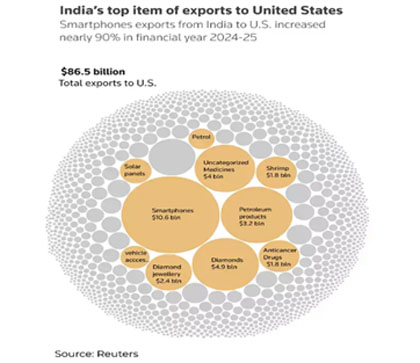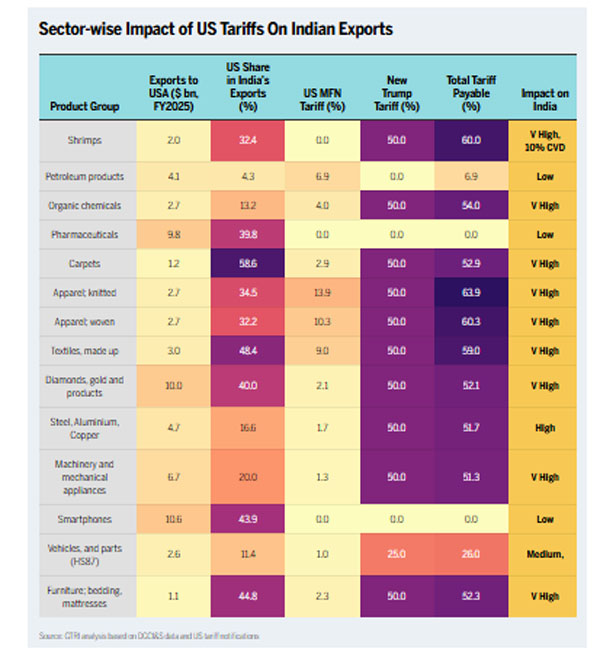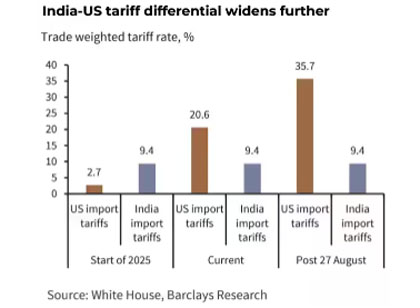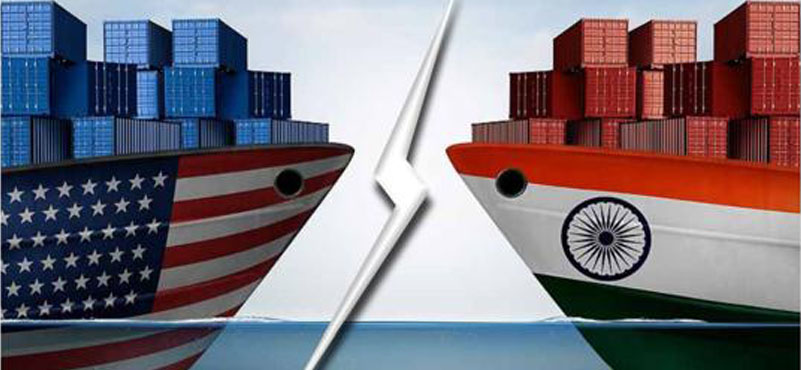The announcement from Washington was blunt and brutal: from August 27, 2025, every Indian export landing on American shores will face a 50% tariff wall. The pretext? India’s continued purchase of Russian oil and arms. The effect? A sledgehammer blow to the world’s fastest-growing major economy and a reckless gamble with one of America’s most consequential partnerships, thereby irreparably breaching the multi-dimensional India-US relations built assiduously over the years.
The Theatre of the Absurd
What makes it interesting is that such an ill-conceived measure is not in the interest of the US. The evidence is overwhelming, the pattern unmistakable. The Smoot-Hawley Tariff of 1930 worsened an already bad recession and drove the American economy into a deep depression– a classic case of the Cobra Effect, where good intentions backfire spectacularly, undermining the core principles of capitalism and free trade. What a remarkable alchemy, the utter futility of it all!
What America needs today is competitiveness, not higher tariffs. Shared prosperity depends on a more connected, secure, and efficient trading environment. The reasons for the so-called ‘tariff terrorism’ include internal weaknesses, such as asset monetization, lower crude prices, lower interest rates, a weaker dollar, and a resurgence in US manufacturing.
The resonating apocalyptic appeal of WB Yeats (The Second Coming, 1919) forces us to look at the future with a sense of trepidation.
“Turning and turning in the widening gyre
The falcon cannot hear the falconer;
Things fall apart; the center cannot hold;
Mere anarchy is loosed upon the world,
The blood-dimmed tide is loosed, and everywhere
The ceremony of innocence is drowned;
The best lack all conviction, while the worst
Are full of passionate intensity.”
Debilitating Impact on India
The hit was immediate and debilitating: textiles and apparel manufacturers in Tirupur, Noida, and Surat ominously stopped production amidst worsening cost competitiveness, rapidly losing out to lower-cost rivals from Vietnam and Bangladesh, giving Indian exporters from these geographies a run for their money.

For decades, India and the US have collaborated to weave an intricate tapestry of trade, technology, defense, and diplomacy. Now, with one sweeping stroke, that fabric risks being torn asunder, with extensive implications for trade, investment, growth, and diplomacy. This significant escalation in protectionist trade policy has immediate and long-term consequences for India’s economy.
A Seismic Shift
India has traditionally enjoyed a trade surplus with the US accounting for nearly 17% of India’s merchandise exports, including key sectors such as pharmaceuticals, textiles, IT services, gems and jewellery, engineering goods, and auto components. The 50% tariff drastically erodes the price competitiveness of these exports in the US market.
Indian exporters, already grappling with decelerating global demand and supply chain disruptions, will face reduced orders, constricted margins, and imminent job losses. Export-oriented sectors, such as textiles and apparel, which are highly price-sensitive, would be the worst hit. For pharmaceuticals, where India is a key supplier of generic drugs to the US, higher tariffs would reduce market share to competitors from countries with preferential trade arrangements. A flat 50% tariff makes these exports instantly uncompetitive.
Reduced export revenues will also worsen India’s current account balance, exacerbating pressure on the rupee and potentially raising imported inflation.
Moving from the Bigger Picture to Granular Implications
- Agriculture: India’s agricultural exports, such as rice, spices, and marine products, which find large markets in the US, will become less competitive. Farmers and small traders could face reduced incomes.
- Gems and Jewellery: This labour-intensive sector, employing about 5 million skilled and semi-skilled workers, could face severe demand compression, leading to retrenchments and layoffs.
- IT and Services: Services may not be directly subject to tariffs. But the move signals an unfriendly trade stance, which could spill over into restrictions on visas and outsourcing.
- Auto and Engineering Goods: Tariffs will erode India’s competitiveness in these medium-technology exports, threatening both manufacturing output and employment. Factories risk slowdowns, workers risk pink slips, and the “Make in India” vision is hit.
- Textiles & Apparel: Margins will evaporate in a sector where pennies decide contracts. Millions of livelihoods are at stake.
- Leather & Footwear: This high labour-intensive and export-oriented sector, facing 50 % tariff- way above the competing countries like Vietnam and Indonesia, will be crippled.
- Pharmaceuticals: Indian generics-lifelines for American households- will cede market share to rivals with easier access. Ironically, American consumers will pay the price, too.
- Shrimps: Shrimp exports to the US will be hugely hit by global competitors, e.g., Ecuador.
Transcending trade flows, this move dents jobs, incomes, and India’s growth story. Exports worth US$48 billion are directly in the line of fire. The knock-on effect on the rupee, inflation, and investor confidence will not be inconsequential.

Macroeconomic Consequences Going Beyond Reducing GDP
At a macro level, the tariffs could widen India’s trade deficit by about 0.5%, dent GDP growth by 0.3–0.5 %, and the rupee may weaken modestly. Why? Because of lower exports, factories running below capacity, exporters defaulting on loans, job losses, and reduced foreign exchange inflows. About ~US$48.2 billion of merchandise exports to the U.S. could face 50% tariffs. Up to 2 million jobs are at risk in the near term. Investor sentiment may weaken, as global firms view the US-India economic relationship as uncertain and politically vulnerable in a world of geopolitical churn. The move may also discourage further foreign direct investment (FDI) into export-oriented industries, as India’s economic stability seems susceptible to Washington’s mood swings. Yet the bigger picture is less gloomy: India’s export base is diversified, its corporate earnings and inflation outlook remain intact, and domestic demand is robust enough to cushion the blow.
India, in its first countermeasure to US President Donald Trump’s 50% tariff on Indian goods, announced dedicated outreach programmes in 40 key markets, including the UK, Japan, and South Korea, to boost textile exports. The targeted push will also cover Germany, France, Italy, Spain, the Netherlands, Poland, Canada, Mexico, Russia, Belgium, Turkiye, the UAE, and Australia.
Diplomatic and Strategic Dimensions
The imposition of such high tariffs challenges the strategic partnership between India and the United States, which had been strengthening in recent years through defense cooperation, technology transfers, and Indo-Pacific collaboration. India rightly perceives the move as unilateral and unjust, especially since it violates World Trade Organization (WTO) principles of non-discrimination and fair trade.
 This is not just a trade war; it’s a test of trust. The India–US relationship has been praised as the “defining partnership of the 21st century.” Defense collaboration, Indo-Pacific efforts, and technology transfers are now imperilled. For India, diplomacy in the dock is a stark reminder that Washington’s rhetoric of partnership often falls apart when domestic political pressures come into play. India might consider retaliatory tariffs on US goods, such as agricultural products, whiskey, and motorcycles, although the imbalance in bilateral trade reduces the impact of such measures. Imposing duties on American whiskey or Harley-Davidsons may hog headlines, but won’t level the playing field. The best response is to diversify by strengthening trade relations with the EU, ASEAN, Africa, Latin America, and by building domestic resilience.
This is not just a trade war; it’s a test of trust. The India–US relationship has been praised as the “defining partnership of the 21st century.” Defense collaboration, Indo-Pacific efforts, and technology transfers are now imperilled. For India, diplomacy in the dock is a stark reminder that Washington’s rhetoric of partnership often falls apart when domestic political pressures come into play. India might consider retaliatory tariffs on US goods, such as agricultural products, whiskey, and motorcycles, although the imbalance in bilateral trade reduces the impact of such measures. Imposing duties on American whiskey or Harley-Davidsons may hog headlines, but won’t level the playing field. The best response is to diversify by strengthening trade relations with the EU, ASEAN, Africa, Latin America, and by building domestic resilience.
Strategic Options and Choices
The path of least resistance is the easiest to take, but is it desirable? No, a resounding no. India’s calibrated overtures- reviving dormant trade pacts, expanding digital and service exports, and enhancing rupee settlement frameworks – have helped cushion the short-term impact.
History reveals that crises often force countries to reinvent themselves. Yet, the deeper question in navigating this new, high-tariff environment remains: Can India use this defining moment to accelerate Make in India 2.0, strengthen supply chains, and diversify export markets to bring about a paradigm shift from the throes of pain to the seeds of long-term gain? An element of the growth-theoretic approach could be to reduce India’s dependence on Chinese inputs while avoiding overt conflict with either the US or China.
Despite the traction of India’s PLI schemes, Make in India 2.0, and the diversification into sunrise sectors, manufacturing is unacceptably low, making the runway to trade self-reliance long and steep. Hence, a broad-spectrum strategy needs to be employed, focusing on:
- Broadening Manufacturing: India’s manufacturing base, stuck at 14% of GDP, must expand to withstand such shocks.
- Supercharging PLIs and FTAs: Push aggressively into sunrise sectors, upgrade FTAs with Europe and the UK, and join deeper value chains.
- Simplifying Tariffs & Attracting Capital: Rationalize tariffs, woo anchor investors, and build ecosystems that can compete globally.
- Exercising Diplomatic Muscle: Use backchannels, creative negotiation, and coalition-building at the WTO to make tariffs politically costly for Washington.
Competitiveness amidst geopolitical churn must now occupy centre stage. The focus must shift from reaction to resilience, from tariff tinkering to long-term trust-building.
There has been pressure on India to provide critical market access across sectors, including dairy, agriculture, digital trade, and pharmaceuticals. But India stood its ground resolutely because of its vulnerabilities and susceptibilities, necessitating the protection of the interests of farmers and small businesses. India also asked for relaxations on higher U. S. steel and aluminium tariffs. India demands fairness, respect, and reciprocity in an unequivocal rejection of a unilateral “take-it-or-leave-it” offer in this evolving landscape.
India’s Lakshman Rekha
An Indian prism requires strategic repositioning and diversified trade outreach to maintain India’s export competitiveness. This tariff terror could be a blessing in disguise, provided domestic firms and industries in India retool their inputs, outputs, and finished products to slash costs and achieve operational efficiency, and an uninterrupted supply chain for growth, structural transformation, resilience, and reducing concentration risk.
A vitalising industrial strategy, more strategic macro initiatives like Make in India, local for global, PLIs, diversifying export basket, and value addition are difficult but not impossible. However, this necessitates swift, synchronised measures by all stakeholders. Such measures include tariff rationalisation, attracting anchor investors, rising participation in global value chains (GVCs), simplifying the tariff structure, and reducing tariffs on imports, where domestic capabilities are inadequate. India must re-negotiate contracts with shared tariff burden where feasible; tighten origin/compliance to avoid secondary frictions; and upgrade FTAs (EU, UK, EFTA implementation), deepen Mexico/Canada links for North America value-chain access.
New Delhi has consistently rejected unilateral “take-it-or-leave-it” deals, whether in agriculture, dairy, or digital trade. Protecting vulnerable farmers and small enterprises is non-negotiable. India seeks reciprocity, not charity; partnership, not coercion.
Simultaneously, India must use backchannels, negotiations, creative diplomacy, and intense lobbying efforts for a multitude of socio-economic, security, and technological reasons in an adroit tight-rope walking. But all’s not lost-no way.
Pathway To the Future- A New Growth Compact
Such extreme tariffs amount to economic blackmail. But they may also be the shock therapy to smash the vicious cycle of complacency and dependence. With industry, policymakers, and diplomats acting in concert, today’s tariff terror could become tomorrow’s transformative trigger.
The task ahead is difficult, but with sincerity of purpose and concerted efforts, we can – and we will-surmount this challenge. What is required is to go full steam ahead and fire on all cylinders to generate sources of competitive advantage. This tipping point is reminiscent of President John F. Kennedy’s Inaugural Address (1961), “With a good conscience our only sure reward, with history the final judge of our deeds, let us go forth to lead the land we love, asking His blessing and His help, but knowing that here on earth God’s work must truly be our own”. We simply cannot give up: when the going gets tough, the tough get going. “This too shall pass”!
For now, the world warily watches a high-stakes drama unfold. Will India bow, break, or bounce back? As Lord Alfred Tennyson wrote in his magnum opus Ulysses, “To strive, to seek, to find, and not to yield”, underscoring the centrality of perseverance and a refusal to succumb to the limitations of age and circumstance. An indefatigable mindset of never say die, deepening domestic value chains,
innovation, business process reengineering (BPR), and product differentiation with a shift from mass-market, price-sensitive products to niche, high-margin offerings despite the vicissitudes of life and economic activity, is necessary to overcome the travails of transition in an increasingly complex and interconnected financial ecosystem. Failure is not an option.
ABOUT THE AUTHOR
 Dr. Manoranjan Sharma is Chief Economist, Infomerics, India. With a brilliant academic record, he has over 250 publications and six books. His views have been cited in the Associated Press, New York; Dow Jones, New York; International Herald Tribune, New York; Wall Street Journal, New York.
Dr. Manoranjan Sharma is Chief Economist, Infomerics, India. With a brilliant academic record, he has over 250 publications and six books. His views have been cited in the Associated Press, New York; Dow Jones, New York; International Herald Tribune, New York; Wall Street Journal, New York.








